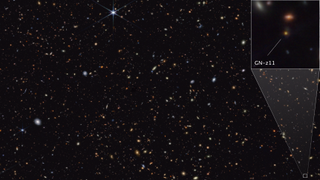James Webb Space Telescope
Latest about James Webb Space Telescope

A new ultrablack coating for telescopes could bring more stars into focus
By Meredith Garofalo published
Next-gen telescopes could see a much clearer picture using a new thin film coating that's incredibly dark.

The James Webb Space Telescope is digging deep into the mysteries of gas planets
By Monisha Ravisetti published
Scientists are slowly getting to the bottom of how some of the universe's most mind-bending worlds came to be.

Speck of light glimpsed by Hubble is truly an enormous old galaxy, James Webb Space Telescope reveals
By Robert Lea published
The James Webb Space Telescope has zoomed in on a mere speck of light seen by Hubble, identifying it as a massive early galaxy that existed just 510 million years after the Big Bang.

James Webb Space Telescope spots the icy building blocks of life swirling around infant stars
By Robert Lea published
Two infant stars are surrounded by swirling clouds that astronomers using the James Webb Space Telescope found contain icy molecules that could form the building blocks of life.

James Webb Space Telescope complicates expanding universe paradox by checking Hubble's work
By Keith Cooper published
The JWST's findings further scientists' conundrum of having different measurements of the expansion of the universe, which may require new physics to resolve.

Oldest 'dead' galaxy ever seen defies current models of the ancient universe
By Samantha Mathewson published
Astronomers have discovered the oldest known "dead" galaxy in recent observations from the James Webb Space Telescope, challenging current models of the early universe.

Icy asteroids help the James Webb Space Telescope uncover Neptune's history
By Robert Lea published
The powerful space telescope zoomed in on Mors-Somnus, a binary pair of icy asteroids that originated within the Kuiper Belt.

How do some black holes get so big? The James Webb Space Telescope may have an answer
By Monisha Ravisetti published
With help from the James Webb Space Telescope, scientists have identified a possible lead on how some supermassive black holes get so incredibly big.

The James Webb Space Telescope may have found some of the very 1st stars
By Keith Cooper published
The hunt for the first stars, known as Population III stars, may be nearing an end as the James Webb Space Telescope spotted tantalizing evidence for them in one of the earliest galaxies known.

The James Webb Space Telescope's targets over the next year include black holes, exomoons, dark energy — and more
By Robert Lea published
The James Webb Telescope will be busy during Cycle 3 , with astronomers using the powerful telescope to hunt exomoons and supermassive black holes and investigate cosmic evolution.
Get the Space.com Newsletter
Breaking space news, the latest updates on rocket launches, skywatching events and more!
